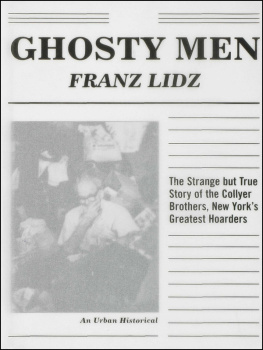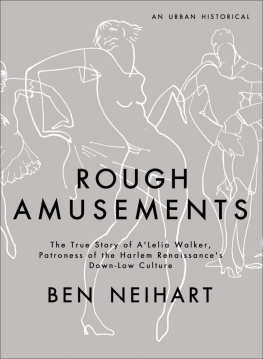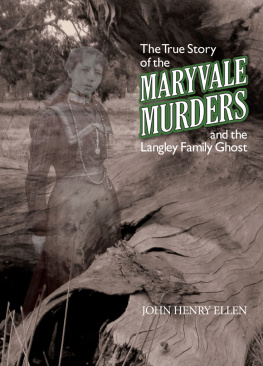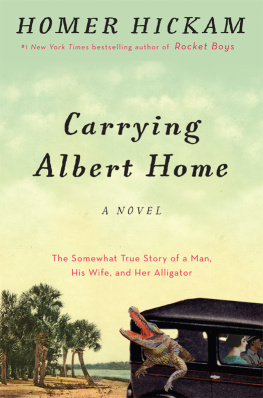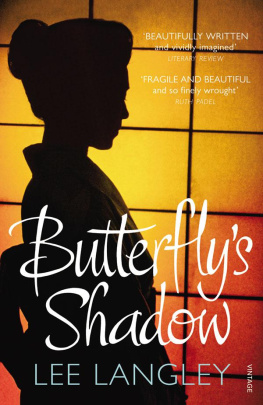Ghosty Men
Ghosty Men
The Strange but True Story of the Collyer Brothers,
New York's Greatest Hoarders
An Urban Historical by
FRANZ LIDZ

Copyright 2003 by Franz Lidz
All rights reserved.
You may not copy, distribute, transmit, reproduce, or otherwise make available this publication (or any part of it) in any form, or by any means (including without limitation electronic, digital, optical, mechanical, photocopying, printing, recording, or otherwise), without the prior written permission of the publisher. Any person who does any unauthorized act in relation to this publication may be liable to criminal prosecution and civil claims for damages. For information address Bloomsbury USA, 1385 Broadway, New York, NY 10018.
Published by Bloomsbury USA, New York
Bloomsbury is a trademark of Bloomsbury Publishing Plc
Library of Congress Cataloging-in-Publication Data has been applied for.
First U.S. Edition 2003
eISBN: 978-1-59691-846-7
To find out more about our authors and books visit www.bloomsbury.com. Here you will find extracts, author interviews, details of forthcoming events and the option to sign up for our newsletters.
For those sardonic sisters, Gogo and Daisy Daisy
All art is the same - an attempt to fill an empty space.
- Samuel Beckett
Contents
Chapter 1
Homer Leaves Home
Homer Collyer left the moldering Harlem brownstone for the first time in seven years in a khaki canvas sack, lowered down a fire truck ladder like dirty laundry in a duffel bag.
Already famous as the "Hermits of Harlem," Homer, blind, paralyzed, and sixty-five, and his brother, Langley, sixty-one, had lived in the four-story mansion since 1909, gradually filling it with... stuff.
Harlem was fashionable, bourgeois, and white when the Collyers moved in, but they became reclusive in a neighborhood that became increasingly shabby, poor, and black.
Stray cats crying in the night were perhaps the first to sense that death had come to the house at Fifth Avenue and 128th Street.
For decades, Langley had fed a multitude of cats around midnight when he set out on his own nocturnal rounds, scavenging through the trash bins of the city. A wraithlike figure in ragged, Dickensian clothes, the old hoodoo rarely left the house during the daylight hours. He had created a sanctuary of junk for himself and his older brother. But on this morning - during the first dark hours of spring on March 21, 1947 - the cats remained hungry and unfed.
Dawn had already come when police received a call from a man who identified himself as "Charles Smith."
"There's a dead man at 2078 Fifth Avenue."
"Name of the deceased?" asked the cop on duty.
"Homer Collyer."
About ten o'clock, a police inspector and about fifteen patrolmen arrived at the decaying house. Reports of Homer's death had often brought police to the Collyer home over the years. But they had been inside only once.
Five years earlier, a police sergeant named John Collins, checking one more rumor that Homer had died, persuaded Langley to let him in through a basement door intricately wired shut against intruders. Collins stumbled along behind Langley for half an hour as he led the way through a pitch-black basement and upstairs through a booby-trapped labyrinth of rubbish.
He found Homer alive and indignant.
"I switched on my flashlight," he said. "And there was Homer, sitting up like a mummy. He was on a cot, a burlap bag beneath him and an old overcoat on the foot of the cot.
"I am Homer L. Collyer, the lawyer," the old man said in a deep voice. "I want your name and shield number. I am not dead!"
"Why are you sitting with your knees up to your chin?" the sergeant asked.
"My legs are doubled by rheumatism. I can never lie down again."
So on this spring morning in 1947, new rumors of death brought a crowd of hundreds and then thousands to wait on the Harlem corner in a cold drizzle while police tried for two hours to get in. The cops closed off the street as it filled up with newspaper reporters, newsreel photographers, and cameramen from a new medium - television.
The house looked deserted. The doors were bolted and the ground-floor windows were covered with rusted iron grilles. The windows were all broken, shuttered, or stuffed with paper.
Police chopped a hole in the front door. Fumes foul with age and mildew billowed forth. The police peered into a solid wall of rotting junk amassed over the decades: shattered sawhorses and fractured frying pans, crushed umbrellas and rusted bi cycles, broken baby carriages and smashed Christmas trees, chipped chandeliers and tattered toys, and everywhere, everywhere, newspapers - thousands and thousands of newspapers, stuffed under furniture, stacked in unsteady piles against walls, strewn in yellowing drifts across the floor.
At a quarter after twelve, the fire department ran a ladder up to a second-story window. Patrolman William Parker climbed up and into the still heart of the hoard. He flashed his light into a cavelike burrow.
"One DOA," he shouted down.
The dead man was Homer Collyer. He sat hunched on the floor about six feet from the window, his body emaciated, his knees pulled up to his chin. He wore only a tattered gray dressing gown. His cheeks were drawn; his dirty white hair and beard uncut for years hung in tangled locks to his waist. His right hand rested near a shriveled apple, a container of rancid milk, and a copy of the Philadelphia Jewish MorningJournal from Sunday, February 22, 1920.
"The place is like a maze," said Detective John Loughery, who followed Parker through the window. "We have to bend double to get through it all."
They dropped Homer to the sidewalk in the khaki body bag. A mortuary ambulance took him away. An autopsy showed that his stomach and digestive tract were empty. The medical examiner said he died of neglect.
At five o'clock the police boarded up the house.
"Where's Langley?" murmured the crowd. "Where's Langley?"
Chapter 2
The Lost Collyer Brother
My mother used to call my uncle Arthur the lost Collyer brother. I was never sure if by "lost" she meant missing, helpless, or that his real name was Langley.
I already knew who Langley was because my father told me cautionary tales about the Collyers as bedtime stories. He had a family full of Collyer brothers, and Uncle Arthur seemed to me much like Langley. Every time I went to visit I remembered the haunted house of the Collyers. Their story has stuck with me to this day, dragged along by my fear that Uncle Arthur would end up like Homer, lost in his junk.
My mom regarded her brother-in-law pretty much the way Tom Sawyer's aunt Polly regarded Huckleberry Finn. They both "cordially hated and dreaded" the irresistible attraction of vagabond outsiders who ignored order, convention, and even cleanliness.
Huck Finn scuffed through the dirt lanes of nineteenth century St. Petersburg, Missouri, dressed in hand-me-down clothes "in perennial bloom and fluttering with rags." Uncle Arthur shuffles through the asphalt streets of twenty-first-century Brooklyn outfitted in layers of Salvation Army overcoats the color of bad weather.
While pirating with Huck on the Mississippi, Tom Sawyer's pockets harbored a lump of chalk, an India-rubber ball, three fishhooks, and "that kind of marbles known as 'sure 'nough crystal.'" While scavenging along the East River, Uncle Arthur's pockets often brim with his own schoolboy treasures: corks, bottle caps, and knots of used shoelaces.
Next page
